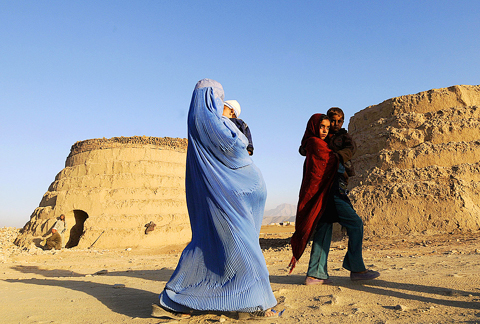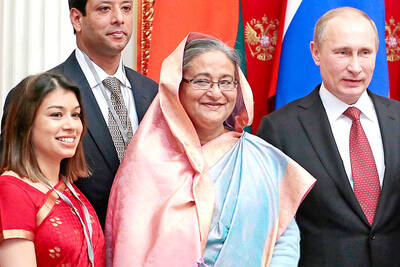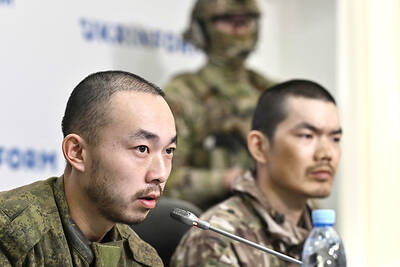The women gave a news conference but asked that no one take pictures showing their faces, and one speaker’s office requested that no one print her name. It’s a lot of secrecy for a press event, but it’s a dangerous time to be a powerful woman in Afghanistan.
Police Major Colonel Sediqa Rasekh and other high-profile women spoke on Thursday at the event to highlight the continuing threat of violence against females in Afghanistan eight years since the hardline Taliban regime was ousted.
Taliban assassins gunned down a senior policewoman in southern Afghanistan in September, and female government officials regularly report receiving threats to their safety from the hardline Islamists.

PHOTO: AFP
A photo in a newspaper can make a woman a target.
“At some point we can become the target of an enemy attack, whether it is shooting, or spraying acid, kidnapping or anything. If they don’t have pictures of us, they will not be able to pick us out,” said Rasekh, who gave express permission for her name to appear in print after her office requested anonymity.
Rasekh said the Taliban have re-emerged as a threat in several parts of Afghanistan.
“The danger has increased significantly,” she said.
When the Taliban ruled Afghanistan from 1996 to 2001, they ordered women to stay home and tend to their families. Girls were banned from schools and women could only leave the house wearing a burqa covering their body and accompanied by a male family member.
The Afghan government and Western donors have made a major push to increase opportunities for women in recent years, but those females who buck tradition to join the government or the military or just speak out about women’s rights put their lives on the line.
“If a woman doing that is taken by the Taliban, of course her head will be taken off,” said Massouda Jalal, whose Jalal Foundation works for women’s rights in Afghanistan.
Nevertheless, Jalal agreed to speak publicly and allowed her photograph to be taken.
“My philosophy is that you are born, and one day you will be dying. So why not die while being an ideal for others?” she said.
The September assassination of the policewoman in Kandahar followed the 2006 killing of a women’s affairs official in the same province. The Taliban claimed responsibility in both attacks.
Women who take prominent positions have to take extreme security measures. Marya Bashir, the country’s only provincial female chief prosecutor, has an armored car and six bodyguards provided by the US. She said she feels much more in danger than she did when she was appointed about two and a half years ago when she had a more standard setup — an unarmored vehicle and three policemen as bodyguards.
“From the time that I was appointed to now, the situation has completely changed. Every day is getting worse” with death threats and attacks, she said.
About a year ago, an explosion outside Bashir’s house injured two of her bodyguards.
“My children cannot go to school because I have got this position,” Bashir said.
She has kept them home for the past 18 months out of fear they will be attacked.
Women’s activists say the Taliban target girls’ schools as part of a campaign to show that programs supported by the West are failing.
There are signs of hope. Central Bamiyan Province, one of the country’s more peaceful regions, has a female governor. And a few women in parliament regularly appear on television campaigning for women’s rights, despite threats.
Rasekh said many of Afghanistan’s female police officers see their uniforms as a public statement against the type of passive protection offered by a burqa. A woman under one of the flowing blue robes is rendered anonymous, even her eyes hidden by a fabric mesh.
“The uniform itself is a sign of courage for women. It shows that we are not afraid,” Rasekh said.

Incumbent Ecuadoran President Daniel Noboa on Sunday claimed a runaway victory in the nation’s presidential election, after voters endorsed the young leader’s “iron fist” approach to rampant cartel violence. With more than 90 percent of the votes counted, the National Election Council said Noboa had an unassailable 12-point lead over his leftist rival Luisa Gonzalez. Official results showed Noboa with 56 percent of the vote, against Gonzalez’s 44 percent — a far bigger winning margin than expected after a virtual tie in the first round. Speaking to jubilant supporters in his hometown of Olon, the 37-year-old president claimed a “historic victory.” “A huge hug

Two Belgian teenagers on Tuesday were charged with wildlife piracy after they were found with thousands of ants packed in test tubes in what Kenyan authorities said was part of a trend in trafficking smaller and lesser-known species. Lornoy David and Seppe Lodewijckx, two 19-year-olds who were arrested on April 5 with 5,000 ants at a guest house, appeared distraught during their appearance before a magistrate in Nairobi and were comforted in the courtroom by relatives. They told the magistrate that they were collecting the ants for fun and did not know that it was illegal. In a separate criminal case, Kenyan Dennis

A judge in Bangladesh issued an arrest warrant for the British member of parliament and former British economic secretary to the treasury Tulip Siddiq, who is a niece of former Bangladeshi prime minister Sheikh Hasina, who was ousted in August last year in a mass uprising that ended her 15-year rule. The Bangladeshi Anti-Corruption Commission has been investigating allegations against Siddiq that she and her family members, including Hasina, illegally received land in a state-owned township project near Dhaka, the capital. Senior Special Judge of Dhaka Metropolitan Zakir Hossain passed the order on Sunday, after considering charges in three separate cases filed

APPORTIONING BLAME: The US president said that there were ‘millions of people dead because of three people’ — Vladimir Putin, Joe Biden and Volodymyr Zelenskiy US President Donald Trump on Monday resumed his attempts to blame Ukrainian President Volodymyr Zelenskiy for Russia’s invasion, falsely accusing him of responsibility for “millions” of deaths. Trump — who had a blazing public row in the Oval Office with Zelenskiy six weeks ago — said the Ukranian shared the blame with Russian President Vladimir Putin, who ordered the February 2022 invasion, and then-US president Joe Biden. Trump told reporters that there were “millions of people dead because of three people.” “Let’s say Putin No. 1, but let’s say Biden, who had no idea what the hell he was doing, No. 2, and